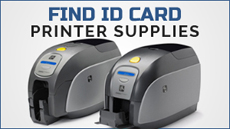Working with Smart CardsTechnology cards also known as smart cards" offer dramatic advancements in ID card security and functionality. Smart cards are small and tamper-resistant. They store, process, communicate and encrypt large amounts of data, including biometric data and monetary values. Smart cards are often used for logical access control to networks or databases, or physical access control to buildings or rooms. Five current Fargo printer/encoders DTC1000Me, DTC1250Me, DTC4250e, DTC4500e and HDP5000 can encode data in up to three different smart card technologies in the same pass as card printing, when optional encoding modules are installed. Smart cards defined
Generally speaking, a smart card is any card with embedded circuitry typically a microprocessor with internal memory programmed to store information or execute tasks. Data transmission is made via either direct physical contact with a reader, or by holding a card within a few inches of a secure contactless interface. Unlike other authentication technologies, smart cards can confirm identities in three ways: - Something you have (a secure ID card)
- Something you know (a password)
- Something you are (a palmprint or eye retinal scan)
Combined, these security layers create the most advanced card security in the marketplace. Types of smart cards
Smart cards fall into two categories: contact and contactless. - Contact smart cards have a copper interface pad embedded on the surface of the card. The card must be inserted into a smart card reader to make a direct connection for the transfer of data. Contact smart cards typically have more memory and processing power than contactless cards. Some data encryption processes (used in high-security financial or legal applications) can only be performed by contact smart cards. Contact smart card readers work well in office environments, but not outdoors or in industrial applications.
- Contactless smart cards only require close proximity to a reader (usually within a few inches) to achieve data transmission. Both the smart card and reader have internal antennas and wireless circuitry for secure communication. Using advanced data encryption techniques, contactless smart cards are every bit as secure as their contact counterparts. Contactless smart cards are ideal for access control, mass transit, vending and cafeteria payment, and dozens of other applications.
Other types of technology cards
While not actually smart cards", these other card technologies can enhance the security and functionality of your ID cards:- Proximity cards bring keyless convenience to physical access control systems. Prox cards contain an internal antenna that cardholders wave within a few inches of the reader to request access.
- Combi" proximity cards integrate photo ID, prox, magnetic stripe and even smart card technology into a single card, eliminating the need to carry multiple cards for different purposes.
- Combi" smart cards allow a single smart chip to securely interface with both contact and contactless readers.
- Hybrid smart cards contain two smart chips one with a contact interface, the other contactless effectively doubling the functionality and security of the card.
- Optical laser cards transform CD-ROM technology into ID card form, capable of securely storing megabytes of information.
|  |
Learn more about smart cards
Find out how smart cards can enhance your operations by contacting (714)922-1140 or e-mail us at [email protected]. You'll also find a wealth of information about smart card technology and applications on the HID Global web site. HID Global is the industry leader in proximity and contactless smart card technologies.
|




